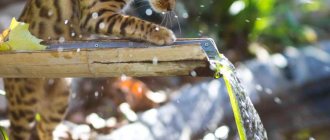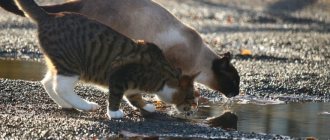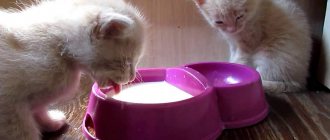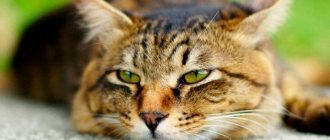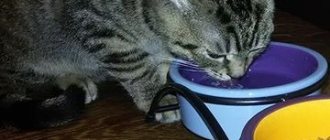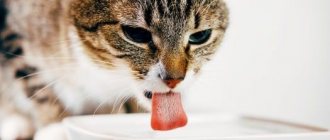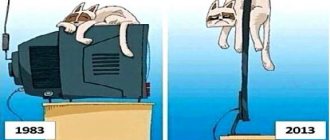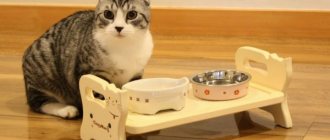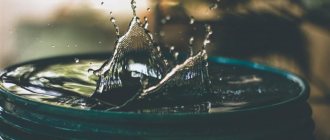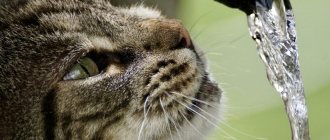The cat refuses water completely
Sometimes a perfectly healthy cat does not want to drink water. Why is this happening?
Check the temperature of the water in the bowl. Cats - unlike people - do not like cold water and are much more willing to drink water that is at room temperature.
If you switched your cat from dry food to wet food, this may cause her to refuse water: she began to receive the required amount of liquid with food and began to drink much less often.
It has been noticed: in the summer, in extreme heat, all cats become real water-drinkers. With the arrival of autumn, especially during the cool and damp period before the start of the heating season, the need for drinking in cats decreases significantly.
But it also happens that a cat, along with refusing water, begins to show anxiety, looks depressed and clearly sick, cries and tries to hide in a secluded corner. These are clear signs of ill health. If, in addition, your cat is vomiting and has an upset stomach, you should immediately take her to the vet.
Liquid consumption rate
When feeding an animal with dry food, it is necessary to provide it with constant access to clean water. On average, a cat should drink about 100-150 ml per day, depending on the weight of the pet. Particularly obese cats need more fluid, kittens need less.
You can accurately calculate the amount of water based on the frequency of supply. On average, one part of dry food should be three parts of water per day. If, in addition to dry food, the animal consumes canned cat food, the amount of water may decrease, since such food is wet and covers half of the daily fluid intake.
We recommend the article: Why does a cat limp on its front leg?
Doesn't drink or go to the toilet
If you find that your pet is not touching water or using the litter box, this could be a sign of urolithiasis or kidney inflammation. In any case, the animal must be examined by a doctor and appropriate treatment prescribed.
Sometimes this can happen due to extreme stress. Cats that had to urgently leave their home with their owners and stay in an unfamiliar place for a long time, with a large crowd of people, may not drink and, accordingly, not go to the litter box for 2-3 days. As soon as the animal finds itself in a calm environment, its condition should normalize on its own.
Benefits of water for cats
Good hydration promotes proper functioning of the kidneys and urinary system. In addition, it prevents the formation of crystals as it increases the dilution of urine and if you go to the sandbox more times, it remains in the bladder less time, which is another factor that contributes to sedimentation.
If water intake is important for healthy cats of any age, it is even more important for those with urinary or kidney problems. In these cases, you should not only follow the advice outlined in the following sections, but also take the cat into the hands of a veterinarian.
Doesn't drink from a bowl
If your pussy won't go to its water bowl, but it feels good and looks completely healthy, first try to determine if it has found a more attractive place for a "watering hole." This could be an open aquarium, a tray for a flower pot (some types of indoor plants prefer to always have water in the tray), a leaking faucet from which it is very interesting to lick the flowing droplets, a puddle in the yard or even a toilet hole...
Check the water bowl. How long has it been since you washed it? Ideally, this should be done every day. Or maybe the old bowl broke and you replaced it with a new one? The cat may not like your choice.
Reasons why a cat doesn't drink water
Of course, water is essential for the health of our cat and should be consumed daily in sufficient quantities, but this does not always happen. Naturally, cats do not drink because they are accustomed to consuming the necessary liquid directly from their prey, which is usually rodents, birds and even lizards with a water content of about 70%. But cats that live indoors do not have the opportunity to hunt and depend on food provided by their owners. I think this is very common with around 8% water content as a result of the manufacturing process.
© shutterstock
Comparing natural prey with this menu, we will understand that the cat must swallow liquids in much larger quantities than she is used to. Consequently, health problems may arise and it is important that we encourage our cat to drink. Therefore, it is normal for us to worry if we notice that our cat is not drinking water. In this sense, one of the most common reasons is that the cat hunts and feeds if it has access from outside. If not, then the reasons may be:
- The cat doesn't like her drinking fountain. In this case, the cat can drink water from other sources, such as a tap.
- The drinking fountain is located too close to the tray. Cats are animals that prefer their space to be well-partitioned, so they may refuse to drink water if their drinking fountain is too close to an area intended for relief.
- Their diet is wet and they already meet their water needs.
- The water is dirty and the cat prefers not to drink. These animals are also known for their neatness, so they refuse to drink water that they consider bad.
- There are several cats, and one or more are preventing the others from drinking water. If your cat has stopped drinking water and you recently adopted another cat, she may be using her resources.
- The cat has a medical condition that causes him to drink less water.
Since he may have health problems, it is important to go to the vet for a checkup. If this reason is excluded, how to teach a cat to drink water? How much water does a cat need to drink per day? In the following sections, we explain what steps we can take to get your cat to drink more, how much water to drink, and what to do if she doesn't drink enough water.
Doesn't drink or eat
When a young kitty suddenly refuses food and water and appears confused and lethargic, calculate how many months she is before running to the vet. Perhaps your pet has entered her first heat and is trying to get used to new sensations.
Another common reason for refusing water and food is worms. After taking the anthelmintic drug, your pet will regain good health and interest in life.
If, in addition, the cat has diarrhea, these are clear signs of a disease of the stomach, liver or pancreas. Only treatment and a change in diet can help here.
Sometimes a complete refusal of food and water is a serious sign of a disease of the blood, respiratory tract or reproductive organs.
In any case, take your pet to the vet. Even if it's just the whims of the cat. You will be sure that she is healthy, and with the help of a specialist you will be able to restore her to her former appetite.
How to offer water to a cat?
When it comes to drinking, cats can be something special. The first step to getting your cat to drink water is, of course, to make sure she has clean, fresh water available 24 hours a day, and it should be changed several times a day. It is recommended to leave several drinking bowls in different parts of the house so that you always have quick access to them. In addition, if there is more than one cat in the house, it is good that they have their own bowls so that everyone can drink in peace without preventing others from accessing this resource.
On the other hand, cats like to distribute their home into different spaces. This means keeping the water separate from the litter box, play area, bed, or other resting surfaces. It is also not good that it is attached to the feeder. In addition, it is necessary to choose a suitable drinking bowl. Sometimes we may notice that our cat does not drink water from the bowl because it is too closed, so that its whiskers rub against the edges, which creates discomfort. Therefore, you should choose wide gutters in which this contact does not occur. The material is also important. Plastic can change over time, so it is recommended to choose stainless steel or ceramic, which are also easy to clean.
Fountains for cats
Sources for cats deserve a separate section. Many of them instinctively reject stagnant water, and we will sometimes see them put their foot in the drinking bowl to move it before they start drinking. Others jump into the tap water as soon as they realize we're opening it, or even open it themselves.
In these cases, cat fountains are a good option because they keep the water moving continuously, which encourages them to drink.
As a recommendation, leave her drinking fountain running at first until she adjusts to using the new fountain.
© shutterstock
Drinks only milk
Little kittens love and digest milk very well. With age, the picture may change: in an adult cat, whole milk most often causes an upset stomach.
But it also happens that until a very advanced age, a cat drinks only milk, categorically refusing water. If you give him wet food, it is quite possible that the moisture contained in it is enough for the animal to function normally. If he is cheerful and active, examinations at the veterinary clinic do not show any abnormalities, there is nothing to worry about.
However, if for some reason you decide to switch such an animal to dry food, it is better to abandon this idea. If there is a lack of fluid, he may develop urolithiasis.
Why should a cat drink enough water?
What is the danger of a cat not drinking enough water? If the reason lies in the physical condition of the animal, then it will weaken even more. To heal internal wounds, especially those with blood loss, fluid intake from the outside is required.
Other negative consequences will be:
- urolithiasis disease;
- decreased immunity;
- weakening of the body.
Lack of water in the body leads to a decrease in the frequency of urination of the animal. Reducing the amount of urine makes it more concentrated, resulting in the precipitation of salts. Stones form in the bladder, and urolithiasis develops with associated complications.
© shutterstock
If a cat drinks very little water, then the mucous membranes of its eyes, nose and mouth dry out. It is more difficult for her to keep her coat clean, especially after defecation. The cat looks unkempt and there is an unpleasant smell of urea coming from the skin.
Cat saliva contains protective substances that destroy pyogenic microorganisms while licking the fur. Dry mouth and nose can cause infection in the cat's body and disease. In a weakened cat’s body, a helminthic infestation develops, fleas appear, and the eyes begin to fester. Lack of water in the body leads to weakening and illness of the animal.
Prevention measures
Prevention rules that will help avoid problems:
- Make sure water and food bowls are always clean.
- Include only high-quality food in your pet's diet.
- Try not to expose your cat to stressful situations.
- Brush the coat regularly. This must be done using a furminator. This procedure will prevent the accumulation of hair in the cat’s gastrointestinal tract after licking.
- Eliminate the presence of cockroaches in the house, which can carry serious infections.
- Protect your pet from contact with street animals.
- Regularly wet-clean the floor.
- Do not give your cat any medications without consulting a doctor.
- Deworm your pet once every 4–6 months.
To protect your animal from a number of diseases, it is recommended to keep outdoor shoes in the closet. This is important to prevent the cat from coming into contact with bacteria that can easily be carried home on the soles.
If a cat loses its appetite and feels unsatisfactory, then there is no need to try to cure it at home. If the provoking factor is not serious and does not pose a threat to life, then the pet will recover in the next 24–48 hours. When this does not happen, you should immediately consult a doctor.
How long can a cat live without water?
There are several factors that affect how long pets can live without fluid:
- Season. Due to the heat, cats need more water in summer than at other times of the year. Therefore, it is much easier to get dehydrated in the summer.
- Age is another very important factor. Kittens will not last long, no more than one day, than adult cats.
- Nutrition. When feeding dry food, more water is required, and its shortage is more acute.
- Breed. There are breeds where the animal hardly drinks water, because it doesn’t really need it, for example the British.
- Activity. Active animals require more fluid than inactive animals.
On average, a cat can live no more than 5 days without water; after two days, serious consequences are possible. If she is sick, the time is reduced to several hours.
Symptoms of dehydration
- Sunken or very dry eyes;
- Dry skin or skin with less elasticity. When the skin is pinched, it does not immediately recover;
- Dry mouth.
- Capillary refill time. When pressing on the gums, it takes time for them to restore their red natural color.
- Increased body temperature and increased heart rate;
- Dyspnea.
If you have these symptoms, your pet should be taken to the veterinarian immediately to find out the cause.
How can you tell if your cat is dehydrated?
Common symptoms of dehydration are:
· Sunken, dry eyes · Pale and discolored gums · Loss of appetite · Lethargy and drowsiness
The easiest way to detect dehydration in a pet is to check the elasticity of its skin. Lightly pinch the skin between your cat's shoulders and then release. If there is enough fluid in the animal's body, the skin will quickly return to its original position. If dehydrated, it will very slowly and gradually “slide” back.
Dehydration can be deadly. If you are unable to encourage your pet to drink water on your own, you may need help from a veterinarian. He will put the animal on a drip and find out the causes of the problem.
The main reasons for refusing water
Possible reasons for a cat refusing water may be:
- the cat receives all the necessary volume of liquid with wet food;
- the cat found a source of drinking in another place unknown to you in the apartment or on the street, for example, in the bathroom or in a puddle while walking;
- contaminated water that has a foreign odor or taste;
- The water container is dirty or has a strong foreign odor;
- change of water source;
- the water is very cold;
- high water hardness;
- proximity of the water container to the toilet;
- change of environment (moving to another home or to another area);
- increase in humidity and (or) decrease in room temperature;
- animal disease;
- mechanical obstructions (such as a stuck bone) or trauma in the mouth;
- postoperative period.
In any case, a cat’s refusal to drink water for 2 days is a good reason to contact a specialist for examination and testing.
Danger of dehydration
Water makes up 65% of a cat's total body weight. With its help, nutrients and oxygen are transported to the tissues of the body. If there is insufficient fluid supply, this process slows down, and the lack of oxygen leads to cell death and disruption of system function.
A decrease in fluid levels also leads to thickening of the blood and increased stress on the heart muscle. If no measures are taken, cardiac arrest will inevitably occur.
Dehydration leads to an increase in the concentration of toxic substances in the blood and urine, which negatively affects the functioning of the kidneys and liver. Without receiving the proper amount of moisture and oxygen, certain areas of the brain gradually begin to die, which is accompanied by nervous phenomena, loss of coordination, convulsions and paralysis.
Ways to increase interest in water
Try changing the bowl. For example, if you have a green plastic bowl, change it to a white ceramic or stainless steel one.
Try different shapes and volumes, different materials. Typically, cats like to drink from large containers: a bucket, pan, vase...
Place several drinking containers in different places so that your cat can easily reach them. Experiment.
Our regular viewer shares his experience of how he managed to interest the cat, and he began to drink more water.
Ksyusha Karapetyan: Thank you for the useful video, Sergey. Our sweet bun also didn't want to drink from the bowl. We cut a 5 liter plastic bottle and put water in it for him. There are still no limits to happiness. The main thing is to change the water every day, otherwise for some reason he also wets his paws in it from time to time.
Add milk or broth to clean water. Many cats like the smell of milk. For an average 200-300 ml bowl, 1-2 ml of milk or broth is enough, and sometimes a few drops are enough. But such water needs to be changed more often, especially in summer, as it quickly deteriorates.
Open tap. The running stream of water from the tap attracts many cats, try it, maybe yours will like it too. Of course, this method has its drawbacks. The quality of tap water is often terrible, so you will have to install a filter. And also someone will need to open and close the tap, that is, you will be tortured by running to the kitchen.
Buy a special drinking fountain. Cat fountains are sold online or in pet stores. They are of different types. In the form of a geyser, when water rises from the bottom and flows down a smooth surface, or a constantly running stream of water or a small waterfall.
Choose any one you like, but take the one that is quieter. Some cats are frightened by the noise from the running pump and are afraid to approach the fountain, below is a comment on the topic.
Tori May: Thank you very much, Sergey. Our cat is not a fan of drinking, even in the heat. We are looking for different ways to give them something to drink and attract them to bowls and jars. We noticed that he liked to drink from a tall ceramic cup, matte, white, filled to the brim. Cats are afraid of fountains because of the noise of the pump; you need to choose a model with a quiet, gurgling sound and adjustable water supply. Cats almost never refuse such models.
Forced drinking. Usually they use a syringe without a needle and carefully pour it into the mouth in small portions, as I show in the video below. But this method is used when other methods do not work, for example during illness.
